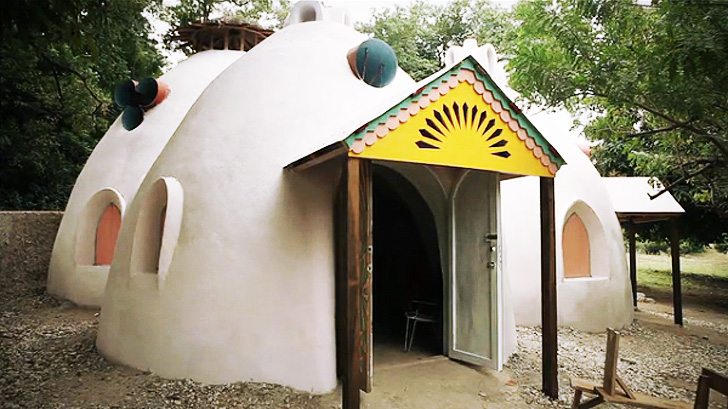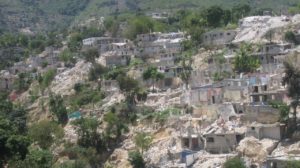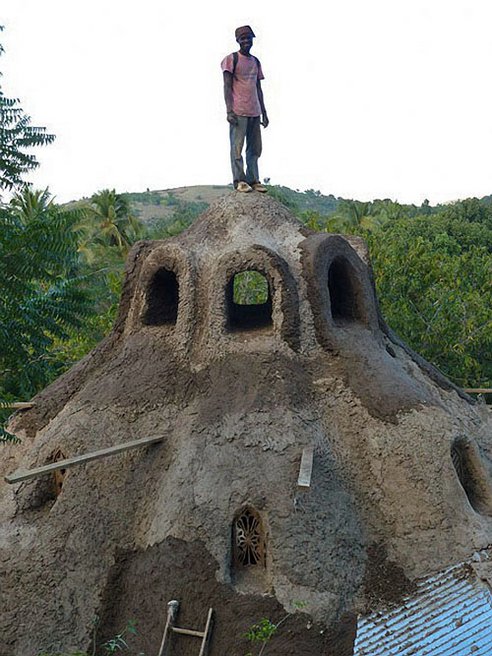Haiti’s recovery from the devastation of the 2010 earthquake, plus repeated hits by tropical storms and hurricanes, calls for creative, low-tech, earth-based alternatives. Konbit Shelter, a pairing of international designers including the street artist Swoon with local artisans, have advanced earthbag construction as a viable solution to disaster prone areas.
A Way Forward — Earth Structures
On Jan. 12, 2010, about 217,000 individuals died in the earthquake that devastated Haiti’s capital Port-au-Prince. An additional 1.5 million people were displaced. Debris has been removed from the streets in Port-au-Prince, Léogane and Pétionville, but at least 500,000 people still live in tents — ripped, torn and tattered by the storms and hurricanes that have hit in the last three years.
Moreover, Haiti faces a cholera crisis, a disease of poverty spread through poor sanitation and contaminated drinking water, yet related to the post-quake effort. The Institute for Justice and Democracy in Haiti (IJDH) is suing the UN to accept responsibility that their peacekeepers brought in the contamination. Bill Clinton and George HW Bush have made magnanimous gestures, backed by thousands of dollars of promised aid — yet little has progressed. The tepid pace of reconstruction even inspired the Canadian International Development Agency (CIDA) to freeze all project funding in Haiti. Hence, grassroots movements carry the most promise in rebuilding the ravaged landscape.
Konbit = Community Shelter
A group of architects, engineers and artists partnered with Konbit Shelter (“konbit” means communal effort in Kreyol), local artisans and builders, to do what international organizations and governments could not, to create durable and low-tech structures tailored to fit each community’s needs. Super-adobe “Earthbag” technology uses layered long fabric tubes or plastic bags filled with adobe: sand, clay, water and fibrous material like sticks, hemp, straw, and/or manure, to create a domed compression structure resistant to earthquakes, hurricanes, floods, fire and termites.
Earthen buildings at present house more than one-third of the world’s population. Thousands of years ago, people discovered and utilized the principles of arch and dome construction. Using the example of military bunker construction, Iranian-born architect Nader Khalili (1936-2008) further developed earthbag for NASA as future human settlements on the Moon and Mars, using moon dust to fill the plastic Super-adobe tubes and Velcro together the layers (instead of barbed wire). By applying this ancient structural technology, combined with a few modern-day materials, Khalili cultivated a dynamic, contemporary form of earthen architecture that he taught at the California Institute of Earth Art and Architecture in Hesperia.
httpvh://youtu.be/MtH7FX6xbTs
Callie Curry “Swoon,” Ben Wolf, KT Tierney, Tod Seelie, and Thaddeus Pawlowski with the help of Fritz Pierre Louis from Leogane, Haiti, spent 6 weeks in Bigones, Haiti building Konbit Shelter.
Simplicity and Economy
Earthbag building provides an easily replicable model, built without specialized construction machinery and can be participated in by the men and women of any community. Utilizing 90% earth, and only 10% cement, these structures are stronger than the now common cinder block and concrete slab construction. Earthbag domes designed with arch openings can eliminate 95 percent of the lumber used to build the average stick-frame house, an invaluable asset in timber depleted Haiti.
Some may wonder how this compares to building with concrete. Expensive, with quality control challenges, concrete also contributes to global climate change. Properly built reinforced concrete structures, which can be engineered to high earthquake-resistance, are not affordable in Haiti and countless other areas around the world. So even with building codes and strong concrete designs, builders in these areas will typically find a way to circumvent codes and/or misappropriate valuable building materials. When a sack of cement costs upwards of a week’s wages, the temptation is just too great.
Disaster Resistant Earthbag Housing
Khalili demonstrated the structural integrity of his raw earth (non-chemically stabilized) earthbag domes. Under static testing conditions simulating seismic, wind and snow loads, the tests surpassed 1991 US Uniform Building Code requirements by 200 percent. These tests were done at CalEarth under supervision of the International Conference of Building Officials. The earthbag system has been proven to withstand the ravages of fire, flooding, hurricanes, termites and two earthquakes with magnitudes of more than 6 and 7.
Structural details can be changed to meet design requirements to deal with disaster risks. For instance, lower walls can be filled with gravel in flood prone areas, and reinforced to resist lateral forces of flowing water. Instead of being swept away like typical wood-framed houses, families can return to their homes after a flood, clean the house and resume their daily lives.
Earthbag buildings are also earthquake resistant. Working with engineers, construction can be adapted to local soil properties and the degree of seismic risk. Engineered plans are now available for building with earthbags in seismic areas.












Pingback: Land Grab in "Paradise": Haiti's Île à Vache Fights Back | WilderUtopia.com
Hi, It’s great work that you and the Haitian community have done. Definitely continue and I look forward to helping. By the way what is the square footage of just one of the domes in white? Is it 120 square feet?
Pingback: On Haiti and Hurricane Matthew – Another Intervention Underway | WilderUtopia.com
Pingback: The Termites Life | Flying Termites